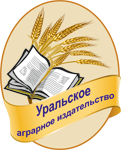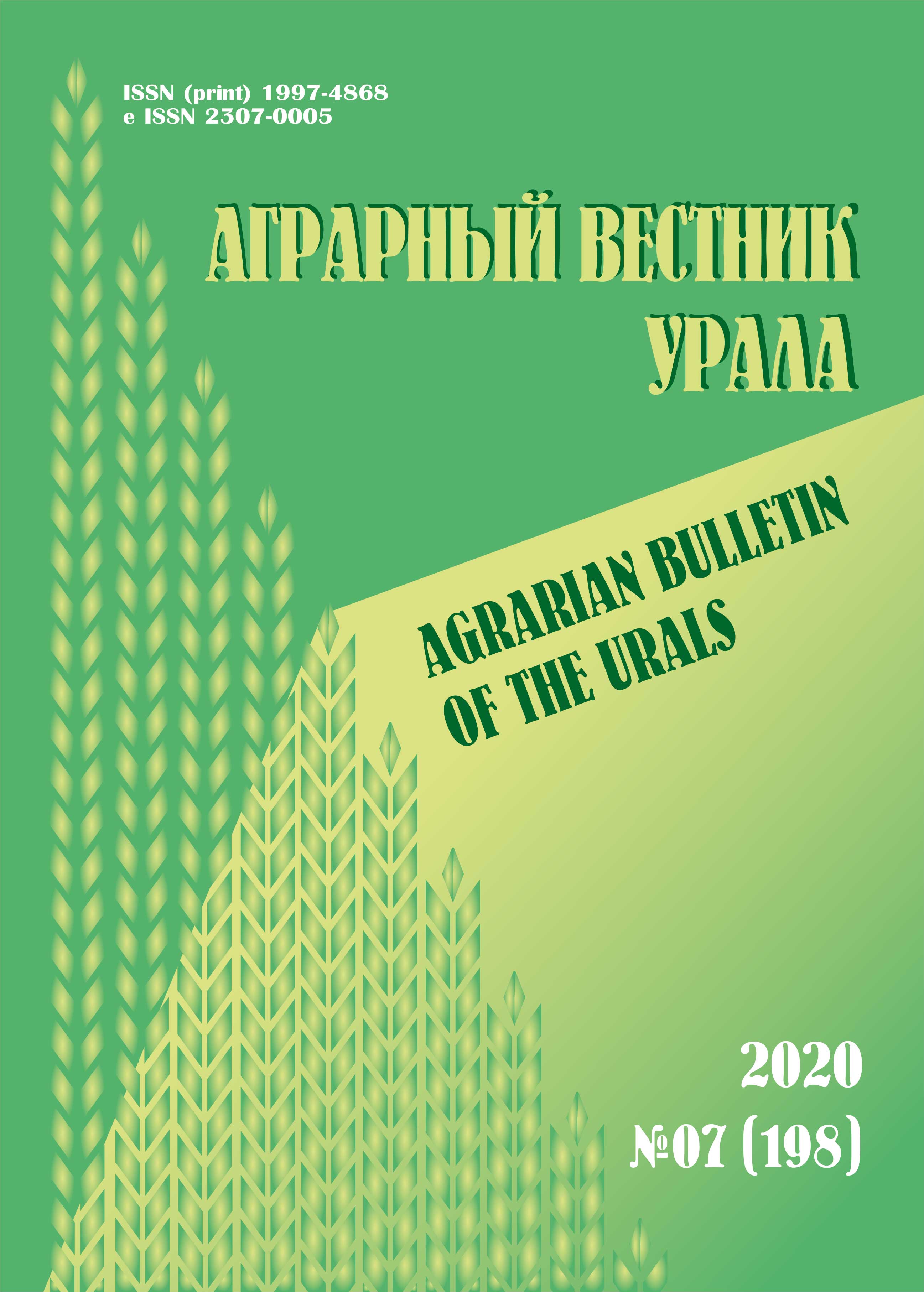Russian Federation
Russian Federation
Russian Federation
Abstract. Purpose. Comparative assessment of productive qualities of cows-daughters of Holstein bulls-producers of different breeding. Methods. Milk productivity was assessed by the method of control milking, milk quality indicators – by the instrument method on the Lactan-1M device, reproductive qualities – by conventional methods. Results. The age of the first insemination influenced the age of the first fruitful insemination and the first calving. Earlier, calving took place for 6 to 9 months in heifers obtained from bulls of Russian and Dutch breeding – Alaska and Davis. The live weight of the repair heifers at the first insemination was almost the same. A higher live weight of the first insemination was in heifers-daughters of bulls Aurora and Relayble. Cows-daughters of bulls-producers of Aurora (Canadian breeding) and Alaska (domestic breeding) were distinguished by lower productivity. They had milk yields for 305 days of lactation and for the entire first lactation lower than the daughters of bulls-producers of Dutch and American breeding – Davis and Relayble. The productive longevity of cows-daughters of all evaluated bulls-producers is slightly more than one lactation 1.0 (Alaska bull) – 1.3 lactation (Aurora bull). According to MFF (mass fraction of fat) and MFP (mass fraction of protein) in milk, the milk of the daughters of the Davis producer bull of the Dutch selection was distinguished by the best indicators. Their MFF in milk was higher by 0.02–0.18 % and MFP by 0.19–0.22 %. The duration of the service period ranges from 101 days (Alaska) to 157 days (Davis). The coefficient of reproductive ability of cows in all groups of cows-daughters was below the optimal 0.95, which indicates problems with reproduction in groups of daughters of bulls of Holstein bulls of different breeding. The daughters of the Alaska bull of the domestic selection had the best CRC indicators (reproductive ability coefficient), and the lowest in the group of the daughters of the Dutch selection Davis bull. Scientific novelty. The scientific novelty of the work lies in the fact that a comprehensive assessment of the economic and useful qualities of the daughters of Holstein bulls of different breeding was carried out and their further use was determined.
Holstein black-and-white cattle, breeding bulls, cows, milk yield, service period, longevity
1. Donnik I. M., Voronin B. A. Proizvodstvo organicheskoy sel'skohozyaystvennoy produkcii kak odno iz vazhneyshih napravleniy razvitiya APK // Agrarnyy vestnik Urala. 2016. № 1 (143). S. 77-81. EDN: https://elibrary.ru/VMFLAF
2. Donnik I. M., Mymrin S. V. Rol' geneticheskih faktorov v povyshenii produktivnosti krupnogo rogatogo skota // Glavnyy zootehnik. 2016. № 8. S. 20-32. EDN: https://elibrary.ru/WGWPQD
3. Kazanceva E. S. Produktivnoe dolgoletie korov cherno-pestroy porody // Molochnohozyaystvennyy vestnik. 2018. № 2. S. 36-43. EDN: https://elibrary.ru/XTWGCT
4. Razhina E. V., Loretc O. G. Vliyanie geneticheskogo potenciala na molochnuyu produktivnost' golshtinizirovannogo cherno-pestrogo skota // Ot importozamescheniya k eksportnomu potencialu: nauchnoe obespechenie innovacionnogo razvitiya zhivotnovodstva i biotehnologiy. Ekaterinburg, 2021. S. 213-214. EDN: https://elibrary.ru/YFPFOW
5. Chechenihina O. S., Smirnova E. S. Biologicheskie i produktivnye osobennosti korov cherno-pestroy porody pri razlichnoy tehnologii doeniya// Molochnohozyaystvennyy vestnik. 2020. № 1 (37). S. 90-102. EDN: https://elibrary.ru/UEOGYV
6. Lihodeevskaya O. E., Gorelik O. V., Loretc O. G. Harakteristika matochnogo pogolov'ya plemennogo reproduktora Sverdlovskoy oblasti // Prioritetnye napravleniya regional'nogo razvitiya: materialy Vserossiyskoy (nacional'noy) nauchno-prakticheskoy konferencii s mezhdunarodnym uchastiem. Kurgan, 2020. S. 716-720. EDN: https://elibrary.ru/JHOCGL
7. Chechenikhina O., Loretts O., Bykova O., Shatskikh E., Gridin V., Topuriya L. Productive qualities of cattle in dependence on genetic and paratypic factors // International Journal of Advanced Biotechnology and Research. 2018. No. 9 (1). Pp. 587-593.
8. Leshonok O.I., Tkachenko I.V., Gridina S.L. Rezul'taty kompleksnoy ocenki bykov-proizvoditeley v plemennyh stadah Sverdlovskoy oblasti // Advances in Agricultural and Biological Sciences. 2016. T. 2. № 1. S. 27-35. EDN: https://elibrary.ru/YOCMGB
9. Skvortsov E., Bykova O., Mymrin V., Skvortsova E., Neverova O., Nabokov V., Kosilov V. Determination of the applicability of robotics in animal husbandry [e-resource] // The Turkish Online Journal of Design Art and Communication 8 (S-MRCHSPCL). 2018. Pp. 291-299. URL: https://www.elibrary.ru/item.asp?id=34958547 (date of reference: 29.11.2021).
10. Mymrin V., Loretts O. Contemporary trends in the formation of economically-beneficial qualities in productive animals // Digital agriculture - development strategy: proceedings of the International Scientific and Practical Conference (ISPC 2019). Ser. “Advances in Intelligent Systems Research”. Ekaterinburg, 2019. Pp. 511-514. DOI: https://doi.org/10.2991/ispc-19.2019.114; EDN: https://elibrary.ru/SLIXAQ
11. Gorelik O. V., Lihodeevskaya O. E., Zezin N. N., Sevostyanov M. Ya., Leshonok O. I. Assessment of the effect of inbreeding on the productive longevity of dairy cattle // AGRITECH-III-2020 IOP Conf. Series: Earth and Environmental Science. 2020. Vol. 548. Article number 082009. DOI:https://doi.org/10.1088/1755-1315/548/8/082009. EDN: https://elibrary.ru/UBUTNR
12. Gorelik O. V., Lavrov A. A., Lavrova Yu. E., Belookov A. A. Prichiny vybytiya korov v zavisimosti ot proishozhdeniya // Agrarnyy vestnik Urala. 2021. № 1 (204). S. 36-45. DOI: https://doi.org/10.32417/1997-4868-2021-204-01-36-45; EDN: https://elibrary.ru/XVVSTF
13. Reshetnikova N. P., Eskin G. E. Sovremennoe sostoyanie i strategiya vosproizvodstva stada pri povyshenii produktivnosti molochnogo skota // Molochnoe i myasnoe skotovodstvo. 2018. № 4. S. 2-4. EDN: https://elibrary.ru/XULDBJ
14. Kolesnikova A. V. Stepen' ispol'zovaniya geneticheskogo potenciala golshtinskih bykov-proizvoditeley razlichnoy selekcii // Zootehniya. 2017. № 1. S. 10-12. EDN: https://elibrary.ru/XWVGGV
15. Molchanova N. V., Sel'cov V. I. Vliyanie metodov razvedeniya na produktivnoe dolgoletie i pozhiznennuyu produktivnost' korov // Zootehniya. 2016. № 9. S. 2-4. EDN: https://elibrary.ru/WMWMYR
16. Zinov'eva N. A. Gaplotipy fertil'nosti golshtinskogo skota // Sel'skohozyaystvennaya biologiya. 2016. № 4. S. 423-435. DOI: https://doi.org/10.15389/agrobiology.2016.4.423rus; EDN: https://elibrary.ru/WKCFPZ
17. Luk'yanov K. I., Fedyaev P. M., Sovremennye tendencii v indeksnoy ocenke plemennoy cennosti molochnogo skota // Genetika i razvedenie zhivotnyh. 2016. № 4. S. 11-19. EDN: https://elibrary.ru/XRURQL
18. Australia’s Three Breeding Indices [e-resource] // DataGene. 2020. URL: https://datagene.com.au/ct-menu-item-7/australia-s-three-indices (date of reference: 24.07.2020).
19. Breeding evaluation [e-resource] // Masterrind. 2020. URL: https://www.masterrind.com/en/breeding-evaluation (date of reference: 24.07.2020)
20. More Genomic Breeding Values on the Spanish scale [e-resource] // EuroGenomics. 2020. URL:http://www.eurogenomics.com/genomic-breeding-values/look-at-rankings/about-gICO.html (date of reference: 24.07.2020).
21. CDN Genetic Evaluation [e-resource] // Canadian Dairy Network. 2020. URL: https://www.cdn.ca/files_ge_articles.php (date of reference: 24.07.2020).
22. Genetic Evaluation - Methods and Definitions [e-resource] // Institut de l’Élevage Idele. 2018. URL: http://idele.fr/no_cache/recherche/publication/idelesolr/recommends/genetic-evaluation-methods-and-definitions.html (date of reference: 24.07.2020).
23. Cole J. B., VanRaden P. M. Symposium review: Possibilities in an age of genomics: The future of selection indices // Journal of Dairy Science. 2018. Vol. 101 (4). Pp. 3686-3701. DOI:https://doi.org/10.3168/jds.2017-13335.
24. Miglior F., Fleming A., Malchiodi F. et al. A 100-Year Review: Identification and genetic selection of economically important traits in dairy cattle // Journal of Dairy Science. 2017. Vol. 100 (12). Pp. 10251-10271. DOI:https://doi.org/10.3168/jds.2017-12968.









